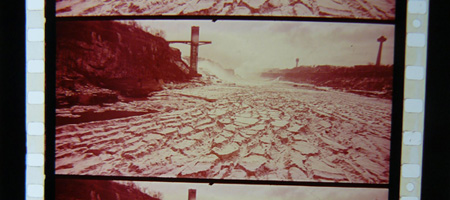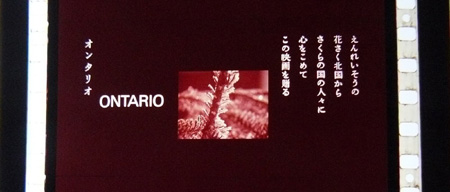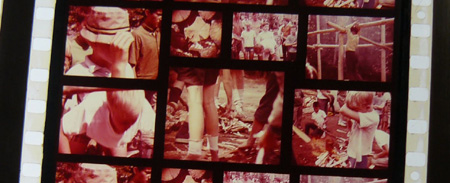"Festival" / "Ontario" | Read more at in70mm.com The 70mm Newsletter |
| Written by: Bill Kretzel, Ottawa, Canada | Date: 02.10.2011 |
 "Festival"
(1971)
(0:20)
/ "Ontario"
(1970) (0:26). Filmed in: 35mm 4 perforations, 24 frames per
second and 65mm 5 perforations, 24 frames per second. Principal photography in:
Most shooting was 35mm 'flat', but the full-screen images were shot on 65mm
stock. Presented on: The curved
screen in 70mm with 6-track magnetic stereo. Aspect ratio: 2,21:1. Country
of origin: Canada. Production year: 1971. World Premiere:
07.09.1971, Ontario Place Cinesphere, Toronto, Canada. German premiere: 09.10.2011 "Festival"
(1971)
(0:20)
/ "Ontario"
(1970) (0:26). Filmed in: 35mm 4 perforations, 24 frames per
second and 65mm 5 perforations, 24 frames per second. Principal photography in:
Most shooting was 35mm 'flat', but the full-screen images were shot on 65mm
stock. Presented on: The curved
screen in 70mm with 6-track magnetic stereo. Aspect ratio: 2,21:1. Country
of origin: Canada. Production year: 1971. World Premiere:
07.09.1971, Ontario Place Cinesphere, Toronto, Canada. German premiere: 09.10.2011A Christopher Chapman Film. Cinematography by Christopher Chapman, C.S.C., Christopher Fryman. Editing by Christopher Chapman. Sound Track Devised and Edited by Ken Heeley-Ray. Original Music Composed and Conducted by William McCauley. Additional Cinematography by Mogens Gander, Dan Gibson, C.S.C., Wescam Mount. John Lowry Productions Limited. Multiple Image Charting Francis Chapman. Optical Effects Film Technique Limited, Toronto. Optical Printer Film Effects of Hollywood. Laboratory Film House Limited, Toronto. Colour Prints Technicolor. Sound Assistant Ann Heeley-Ray. Additional Sound Recording George Reid. Sound Mix Studio Sound Services, Toronto. Sound Mixer Clarke Daprato. Music Recording Eastern Sound Services. General Assistant Victor Noble. By Permission of Actor’s Equity Association: The National Ballet of Canada. The National Theatre of Canada Choir & The Toronto Mendelssohn Choir. Director Elmer Iseler. Production Secretary Penny Grey. Associate Producer Francis Chapman. Producer/Director Christopher Chapman. | More in 70mm reading: Canadian 70mm Short Films Schauburg 2011 Festival Program The Lost Dominion 70mm Film Festival CINERAMA and large-frame motion picture exhibition in Canada 1954-1974 Internet link: Large format in Canada Chris Chapman on Canadian Film Encyclopadia |
Background | |
 "Festival" is a slightly shortened (20 min.) version of "Ontario" (26 min.)
which was commissioned as the feature attraction for the Ontario Pavilion at
Expo 70 - the Universal and International Exposition at Osaka, Japan, where
it was premiered to the public on March 15, 1970 and presented continuously
daily until September 13, 1970 in a 650-capacity cinema. "Festival" premiered
to the public at Ontario Place Cinesphere, Toronto on September 7, 1971 as
part of the daily repertory screening schedule to October 11, 1971. "Festival" is a slightly shortened (20 min.) version of "Ontario" (26 min.)
which was commissioned as the feature attraction for the Ontario Pavilion at
Expo 70 - the Universal and International Exposition at Osaka, Japan, where
it was premiered to the public on March 15, 1970 and presented continuously
daily until September 13, 1970 in a 650-capacity cinema. "Festival" premiered
to the public at Ontario Place Cinesphere, Toronto on September 7, 1971 as
part of the daily repertory screening schedule to October 11, 1971. | |
Newspaper/Magazine Articles (transcribed) | |
Now Chris has his Oscar, it’s on to Osaka!
| |
 His next film about the glories of Ontario - said Christopher Chapman,
gripping his Oscar familiarly around the midriff - will be more about
Ontario people, less about Ontario things. His next film about the glories of Ontario - said Christopher Chapman,
gripping his Oscar familiarly around the midriff - will be more about
Ontario people, less about Ontario things.That will be his film for the Ontario Government to be shown at Expo 70 in Osaka. It’s his second for Ontario; the first was "A Place to Stand", shown at Expo last year and the reason why he had the Oscar now. “Remember that Osaka will be the first Oriental Expo to be held,” said Chapman, taking a Toronto watering break on the way back from Hollywood to his home in Cedar Grove, a tiny farming community near Markham. “I think we can tell the Orient about ourselves in a way that can be quite exciting - but in a way that you wouldn’t use if your were doing it for Ontario, but which when Ontario people see it will be interesting and new. “I’m going to concentrate on people - after all, we can’t really impress the Japanese with our industries. We can’t say: ‘Look, we build ships too’ when ours are canoes compared with theirs. Or, ‘Look we build cars as well’ when they build original cars.” Budget for the new movie will be rather more than the $500,000 for "A Place to Stand". It will last about the same time (18 minutes); he’ll start shooting this June, editing in December 1969. Above all it will be in a form of the multi-dynamic screen technique - a variety of images projected onto one screen by one projector. This was the technique he used successfully in "A Place to Stand", a movie that has had Hollywood on its heels for months, has been widely popular among the Bel Air private-screening-room set, and has been screened about 200 times for the major Hollywood studios. It was something entirely new for Chapman when he started making the film in 1965. “You have to be very careful with movement if you’re using several images,” he said. “If you allow too much in one part of the screen, it will distract terribly from the rest. So you have to shoot a lot of things that in themselves, alone on the screen, wouldn’t have been very interesting, but were very important when used to compliment other images.” Chapman was last in Hollywood for six months last year working on rear-projection film for the Gower Champion production of The Happy Time, starring Robert Goulet, for Broadway. It wasn’t a particularly happy time for Chapman. He looked on it as a great opportunity for mixing stage and film, “but it was headed for disaster from the very beginning.” The script was altered constantly, the leading lady was changed three times, and Goulet, possibly rightly, complained that the film distracted from the stage performance. Result: almost nothing of Chapman’s six-months work is now to be seen in the Broadway production. Whatever one’s private view of what a successful moviemaker should look like, it’s safe to say that Chapman doesn’t fit in. In Toronto he was an arresting combo of natty dress and a generally tousled physique - a kind of walking mixed media of his own. "A Place to Stand" has given hi wide public fame, but five of his other short films have won 14 awards between them since he gave up an advertising job and made "The Seasons" (for Imperial Oil) in 1962. He speaks gently and with great conviction, and is at pains, without being pushy about it, to explain the help he’s had from the Ontario Government, from David Mackay (executive producer of "A Place to Stand"), from Barry Gordon (technical producer of "A Place" and "The Happy Time"). With "A Place to Stand", he said, he just wanted to make a film that made people “feel good.” No, he genuinely had not thought it would win an Oscar “because promotion is very big out there, and the members of the Academy don’t have to see the film to vote on it.” He added: “but the Oscar does mean a tremendous amount to Canada at the moment, because we’re right in the throes of thinking about our theatrical film future. Recognition of this kind gives an impetus to it all.” It’s easy, of course, for Chapman to be dispassionate about an Oscar, now that he has one; even easier since he lives in rustic seclusion in Ontari-ario. But he has been tempted by Hollywood: specifically to do a multi-dynamic feature film for Steve McQueen. He turned it down for the Ontario Government and Osaka. “The multi-dynamic screen is truly a new language,” said Chapman, “and it provides a new dimension, too, for feature films - provided the technique controls the dramatic concept rather than the other way around. It’ll be very hard for it to fulfil its potential if it isn’t used by people who understand it...” | |
What Canada’s up to at Expo 70 - Ontario
| |
 The Ontario Pavilion is Christopher Chapman’s. The Ontario Pavilion is Christopher Chapman’s.The filmmaker who won an Oscar for "A Place to Stand", his split screen celebration of Ontario for the provincial pavilion at Expo 67, has virtually the whole place to himself this time. The pavilion itself is basic blue and white, boxy, windowless - a theatre. Besides Chapman, it has a multi-screen, multi-image show in a room 120 feet long but made to seem longer by mirrors. Slides are programmed to appear across a 100-foot screen. You watch one section of the screen for a few minutes, starting with the Ontario landscape - then you walk along to see industry, social life and so on... From this theatre you walk down three ramps and wait until at least 650 of you have gathered to see the Chapman film on a curved screen ("A Place to Stand" was shown on a flat screen). Technically, as Chapman himself admits, the split-screen hasn’t progressed much beyond 1967. He uses similar combinations of several shot on screen at one time, the same squares and rectangular images. Otherwise, the film is far superior to "A Place to Stand". The sound is on an astonishing 12-track system and its 300 speakers encircle the audience. Panning the camera across a scene means more now that the sound precisely corresponds to the action. Chapman uses much more natural music recorded on location: Indian drums, Mariposa folk singers, a very bad small-town band. The soundtrack also has the Toronto Mendelssohn Choir, but there’s no hit-song material like 1967’s Ontari-ari-ari-o. Because the movie runs 26 minutes, the sequences are longer than in "A Place to Stand". There’s more work with two cameras showing different sides of the same scene. But the most important difference is the theme: this film is about human beings, not buildings and bulldozers. It opens with a frosty spruce bough very small on the huge screen. Then it breaks into a checkerboard of 15 images of a spring stream. But most of the movie is people. Germans, 2,000 strong at an Ottawa party, drinking to the strains of Lili Marlene. An Italian festival with boys slipping on a greased pole and girls playing a very sexy football game in their bikinis. West Indians on Toronto Island swinging trough their Caribana carnival. The final view of Ontario is good old Niagara Falls filmed from a startling new perspective. The camera is on a helicopter five feet above the winter water and it sweeps everybody in the theatre over the brink of the falls and down into the foam below and then gradually up and away for a long shot of the ice-laden falls. | |
| Go: back - top - back issues - news index Updated 22-01-25 |
